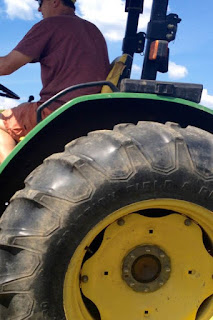I come from a family
where the earth means something. For my maternal grandfather, that “something”
was income and vocation; he still lives in the same farmhouse in Grafton, OH
where he was born, and the fields surrounding it were once home to cows and
chickens and crops that literally fed his family but also fed the family with steady
financial resources. As my mom and her five siblings got older, he stopped
growing corn and hay and beans and started growing family trees instead, as four of his six children were given a chunk of his farm as land on which to
build their homes. He still keeps a medium sized garden by his home, and the
output of his vegetables is a source of pride for him as he ages. Likewise, my
mom is happiest with her hands in the dirt, creating fresh flower arrangements
and quite enjoying it when her zinnias grow behind the height of the mailbox in
her driveway
My dad grew up spending
summer weeks with his maternal grandfather in Circleville, OH. It planted a
seed within him of a dream to live a similar lifestyle, where there is always a
project that needs fixing, plenty of space to see nature, and a visible cycle
of life to watch in fields and animals. While farming is a full-time job for
many, for my dad it is his hobby in addition to work. As I have grown older, my
image of my dad has changed from a man in casual scrubs to one wearing flannel,
well-used jeans, and the occasional John Deere cap. He raises draft horses,
specifically Belgians, and this weekend I was home with him to help with the
summer’s second cutting of hay.
For those who don’t
know much about making hay, it is a simple yet lengthy process. First, you need
a streak of dry and hot days. From there, it takes a lot of equipment pulled by
tractors. The hay is mowed down into strips, then tedded (a farm word for spread
out to dry), then usually tedded again a day or two later to dry the flipside,
then raked into neat lines, which are then scooped up by a hay baler, shaped
into square or round bales, and collected into wagons or dropped back in the
field to be picked up later. This second cutting was a standard square bale day
for us, and we churned out 800+ bales in a few days.
The thing about hay
baling is that it exposes you to the earth’s rawness. Life in a field of
freshly mowed hay is teeming with grasshoppers, birds, sunlight, dust, bees, heat,
that fresh cut grass smell…this weekend, as I walked around these fields, I
couldn’t help but feel the reality that people have been doing this very
process, experiencing these same senses, for generations. My dad, my maternal grandfather,
and my paternal great-grandfather all are connected by harvesting hay from the
earth. The love of the land roots them together as they prepare their barns for
the winter that is always coming.
At one point this
weekend, my dad looked at me and said, “This is good work for a dad and his children
to do together.” I often complain about hay season, because it’s hot, and the bales
cut up your arms and legs, and there’s always another wagon to unload. But this
weekend, I felt a part of something, this generational unity passed down
through earth’s abundance. Whitman made the earth’s turf famous in his Leaves of Grass collection, where he writes,
“I believe a blade of grass is no less than the journey-work of the stars.”
Amen, Walt. Perhaps that while we lose ourselves in cosmic wonder, there is
equal wonder below our feet, in the most ordinary of nature’s output. Grass is
food for our animals, our summertime blanket, a soft cushion for the diving
outfielder, the clothing of bare earth. And on the farm, grass brings
generations together.




